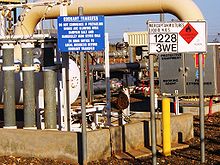- Butanethiol
-
Butanethiol 
 Butane-1-thiolOther namesButyl mercaptan
Butane-1-thiolOther namesButyl mercaptan
n-Butyl mercaptan
1-Butanethiol
Thiobutyl alcohol
MercaptobutaneIdentifiers CAS number 109-79-5 
PubChem 8012 ChemSpider 7721 
UNII 77OY909F30 
Jmol-3D images Image 1 - SCCCC
Properties Molecular formula C4H10S Molar mass 90.19 g mol−1 Appearance Nauseating clear liquid Density 0.83679 g/mL Melting point -115.8 °C, 157 K, -176 °F
Boiling point 98.2 °C, 371 K, 209 °F
Solubility in water Slightly soluble Hazards NFPA 704  (verify) (what is:
(verify) (what is:  /
/ ?)
?)
Except where noted otherwise, data are given for materials in their standard state (at 25 °C, 100 kPa)Infobox references Butanethiol, also known as butyl mercaptan, is a volatile, clear to yellowish liquid with a fetid (extremely foul-smelling) odor, commonly described as "skunk" odor. In fact, butanethiol is structurally similar to several major constituents of a skunk's defensive spray. The scent of butanethiol is so strong that the human nose can easily detect it in the air at concentrations as low as 10 parts per billion.
Contents
Chemistry
Butanethiol is chemically classified among the thiols, which are organic compounds with molecular formulas and structural formulas similar to alcohols, except that sulfur-containing sulfhydryl group (-SH) replaces the oxygen-containing hydroxyl group in the molecule. Butanethiol's basic molecular formula is C4H9SH, and its structural formula is similar to that of the alcohol n-butanol. Butanethiol is a thiol of low molecular weight, and it is highly flammable.
Uses
Butanethiol is used as an industrial solvent, as an odorant for natural gas (which is odorless), and as an intermediate for insecticides and herbicides. It is sometimes placed in the "stink bombs" and "stink perfumes" for pranksters.
Safety
Butanethiol is a very noxious and caustic chemical compound, and at sufficiently high concentrations, it produces serious health effects in both humans and animals, especially as a result of prolonged exposure. Sufficiently high concentrations of the fetid, volatile substance causes eye irritation, headaches, nausea and vomiting, dizziness, and irritation of the respiratory tract. Even higher concentrations can lead to unconsciousness and coma after prolonged exposure. Contact with the skin and mucous membranes causes burns, and contact with the eyes can lead to blurred vision or complete blindness.
See also
- tert-Butylthiol (tert-butyl mercaptan)
Notes
References
External links
Categories:- Thiols
Wikimedia Foundation. 2010.


